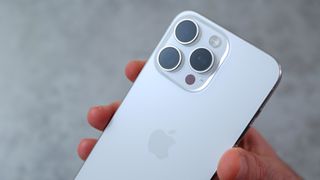
Top Picks ↵
1. Best overall for photo and video
2. Best for photography
3. Best for high-resolution photos
4. Best for affordability
5. Best for novice shooters
6. Best foldable phone
7. Best flip phone
8. Best camera foldable
9. Best for cinematographers
10. Best underdog
11. Best flagship at a lower price
12. Best last-gen Apple
How to choose
How we test
FAQs
The best camera phones offer a tantalizing combination of the pinnacle of imaging technology with pin-sharp displays and lightning-fast internet connectivity. In fact, some handsets can deliver better photographs than the 'proper' camera you might otherwise be tempted to pick up.
As camera phone technology progresses, you might find it tricky to keep up to date on the latest handsets available. Our phone rumors hub will keep you up to date with the latest leaks and smartphone news. But to help you find the best camera phone for you right now, we've rounded up a selection of the latest models with a range of budgets in mind.
Camera phone technology can really boil down to one simple concept – pure and simple convenience. Not only will the best camera phones feature powerful imaging sensors (for example, the Samsung Galaxy S23 Ultra has an awesome 200MP sensor – higher than most of the best professional cameras), but they'll also have incredible computational photography features that take a matter of milliseconds to process the images you capture and improve aspects such as sharpness, white balance and more.
While the best camera phones might not yet be able to beat the best DSLRs or mirrorless cameras for sheer image quality, the one area that camera phones beat out traditional cameras in is their size. Even the best compact cameras can still take up most of your pocket (if they even fit in!), but the best fold phones such as the Samsung Galaxy Z Flip 5 and the Samsung Galaxy Z Fold 5 are incredibly compact.
No matter whether you're looking for a high-end camera phone that will help you capture great social media content, or you're simply looking for an everyday handset that will capture beautiful family snaps, we've rounded up the best camera phones currently available below…
The best camera phone: Our top picks
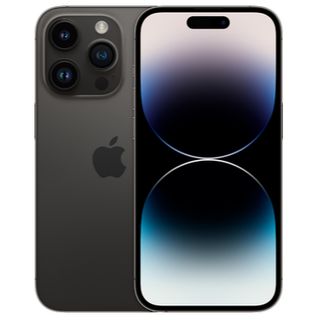
The iPhone 15 Pro Max is a serious, pocketable powerhouse. Yes, its ample cameras provide 48MP RAW stills and up to a 5x optical zoom, but its video really shines through. Read more below...
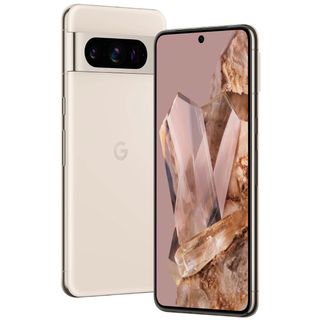
The Pixel 8 Pro is simply the best camera photos you can take using a phone, at a much lower price than its Apple rival. Read more below...

The Samsung Galaxy S23 Ultra is one pretty phone that also benefits from an impressive 200MP camera. Read more below...
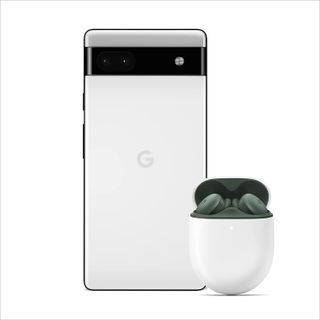
If you're looking for a great photo-taker for an amazing price then the Google Pixel 7a takes the crown. Read more below...
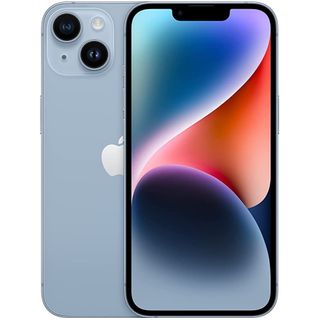
The iPhone 15 might not be top-spec, but it is the best shooter for everyday phone photographers. Read more below...
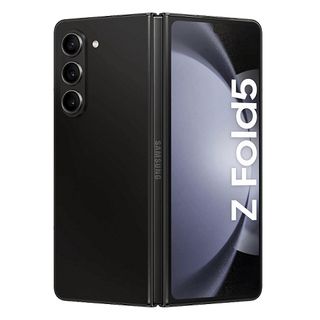
One of the best foldable phones on the market, with great cameras. Read more below...
The best camera phone in 2023
Why you can trust Digital Camera World Our expert reviewers spend hours testing and comparing products and services so you can choose the best for you. Find out how we test.
The best phone overall for photo and video
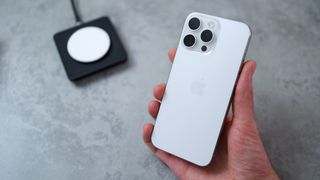
The iPhone 15 Pro Max is a serious, pocketable powerhouse. Yes, it's thick, but its relatively compact footprint and ample camera and power mix make it an enticing option, especially for photographers.
While it's a shame there's no pro mode for manual photography, the 14 Pro's 48MP RAW photos capture excellent results. The automatic mode's photo processing is also one of the best if not the best, we've seen on a phone. Additionally, the iPhone Pro Max now offers up a new 5x telephoto camera, reaching further can ever before in higher quality, and offering even more beautiful natural blur on portraits.
The iPhone 15 range has also added a tremendous amount of functionality and convenience by finally adopting the USB-C port, making it even more compatible with monitors and camera accessories.
So while the new iPhone 15 Pro is very expensive, it's a mighty phone with a brilliant camera, that's powerful and lasts a full day. If you're an Apple fan who likes more compact phones, the iPhone 15 Pro is a no-brainer, but you will be bumped down to a still very impressive 3x optical camera. But if you like big phones and the best photography experience, the Pro Max is for you.
Read more: iPhone 15 Pro Max review
The best phone for photography
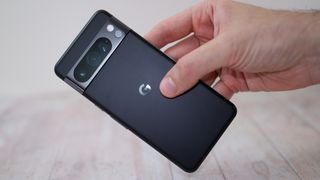
The Pixel 8 Pro is simply the best camera you can buy at its price for photography, it's that simple. It wipes the floor with the similarly priced iPhone 15 Pro and beats the much pricier iPhone 14 Pro Max in a few key areas too.
The Pixel 8 Pro adds a new RAW capture letting you take full advantage of the 50MP sensor, as well as a new pro controls mode giving you manual control over the look of your images. The camera mix is still mind-bogglingly good as far as point-and-shoot photography goes, with a new higher-megapixel wide-angle lens, and one of the best telephotos on the market. Video has also taken a big step up from the 7 Pro but can't quite meet the iPhone Pro Max.
With a sleek design, a mighty screen, and excellent future-proofing by way of continued software support for up to 7 years, you do get a lot for your money here. So even though the phone had a couple of small hiccups in our time with it – as a package, you'll be hard-pressed to get a better value flagship phone than the Pixel 8 Pro.
Read more: Google Pixel 8 Pro review
The best phone for high resolution photos
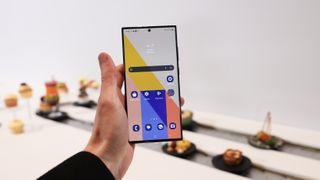
Immediately upon seeing the Samsung Galaxy S23 Ultra, we concluded that this is one pretty phone. Samsung has doubled down on the clean minimal style this year, and it has really paid off, with a cool sophisticated style, that is also distinctly different from the other big manufacturers.
The screen is big, bright, and colorful with a near-bezeless curved screen, that is a joy to behold. On the rear of the phone, the camera cutout has been replaced by each lens sitting alone nearly flush with the device. The S Pen continues to be tucked in the bottom of the phone ready for note-taking at a moment's notice.
Meanwhile, this Android phone does have power! With the latest Snapdragon 8 Gen 2 for Galaxy, you can expect to fly through daily tasks, mobile gaming, and content creation. When it comes to photography, Samsung is not playing around. With a new 200MP camera sensor, which can now capture 50MP RAW photos, and new AI processing algorithms specializing in new nighttime and astrophotography, this phone packs some serious chops when it comes to photography.
Read more: Samsung Galaxy S23 Ultra review
The best camera phone for affordability

One of the best budget camera phones out now, if not the best, the Google Pixel 7a offers much of the same photo quality as its much more expensive flagship offering, the Google Pixel 7 Pro.
Costing midrange money, though, it's clear where Google's compromised. The Pixel 6a has a lower refresh rate screen than the competition, fewer cameras, and no wireless charging. However, Google doesn't usually deliver best-in-class power, instead focusing on smarts, and that's what it's done with the Pixel 6a. It features a mighty Google Tensor chip with top-end features like an under-display fingerprint scanner and AI photo editing powers.
Despite its slightly underpowered hardware, the 7a is a powerful camera phone thanks to Google's smart software, enjoys playful design, and offers plenty of bang for your buck.
Read more: Google Pixel 7a review
The best camera phone for novice shooters
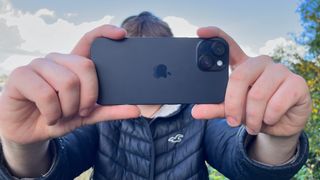
From a photography point of view, the iPhone 15 is a great piece of kit, especially if you just want to point, shoot, and share great-looking shots via social media without doing much post-processing.
However, the more serious photographer will miss the ability to shoot in RAW format so that they can enjoy fine-tuning the look of their images in a digital darkroom such as Adobe Camera Raw.
Images on the iPhone 15’s Super Retina XDR display look great, but you may need to view them on a larger display if you want to discover and remove noise artifacts or retouch a portrait more effectively. In this instance, you might consider paying an extra £100 for the iPhone 15 Plus, which boasts a true optical 3x camera, rather than the iPhone 15's pixel-binning trickery.
The iPhone 15’s video especially shines and produces amazingly smooth handheld footage which alleviates the need to stabilize it in a non-linear editing app, but serious filmmakers may also want the option to shoot in HDR Dolby Vision, which will lead them in the direction of the iPhone 14 Pro or Pro Max.
Read more: Apple iPhone 15 review
The best foldable phone

Samsung's raised its prices for 2023 compared to the previous Fold 4 and matched the Pixel Fold's asking price directly. But Galaxy Z Fold 4 owners who dropped the best part of $2000 on the Galaxy Z Fold 3 or Z Fold 4 shouldn't look at the Z Fold 5 and feel like they're missing any killer features, but that doesn't stop the new phone from being a powerhouse.
Samsung has not really overhauled its Z Fold line with its latest release. But while the Z Fold 5 is very similar to the Z Fold 4, it's still one of the most fully-featured folding phones out there, with its S Pen support and foldable-optimized interface helping it shine, while it carries forward the competent camera system of its predecessor. If you are already invested in the Samsung ecosystem then this phone also fits perfectly in with your other Samsung devices.
Read more: Samsung Galaxy Z Fold 5 hands-on review
The best flip phone
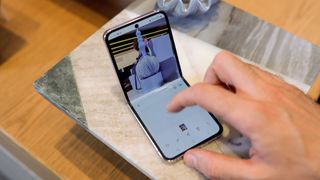
Samsung's strange side-notch on the Z Flip 5 might not look as good as Motorola's RAZR 40 Ultra cover screen, but if it makes room for better camera hardware, we're here for it. The fact the Z Flip 5 upgrades the cover-screen functionality to run third-party apps, levels up the line's power, and zaps the hinge gap of old Samsung clamshells all means this is the most exciting Z Flip since the first debuted in 2021.
Read more: Samsung Galaxy Z Flip 5 hands-on review
The best cameras on a foldable phone

On the one hand, the Pixel Fold is a very first-gen device. It doesn't unfold completely flat, and there are plenty of mainstream Android apps that don't look great on it – or any unfolded folding phone (or Android tablet, for that matter).
But in the Pixel Fold's favor, it's an IPX8-rated foldable with a very sturdy hinge – so durability is where it needs to be, at least on paper. Its cameras also benefit from the Pixel treatment, so while its hardware isn't best-in-class, its photos are consistently balanced. Most noteworthy, the Pixel Fold's periscope camera is a welcome win over its main competition, the Galaxy Z Fold 5, and its shooting modes are very user-friendly.
Read more: Google Pixel Fold review
The best phone for cinematographers
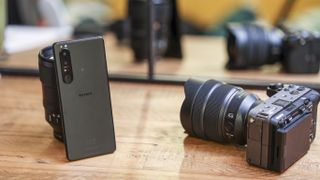
The Sony Xperia 1 III is the only choice for video pros and cinema buffs who want to get manual with their smartphone videography. It’s able to shoot footage at up to 21:9 for cinema-style capture, offers full manual control, and features a beautiful flat color profile, perfect for post-processing in Premiere Pro or Da Vinci Resolve.
Thankfully, almost everything else about this phone is excellent too, with a striking 21:9, 4K HDR screen, a clean UI, and a snappy chipset ensuring plenty of power under the hood. Sony photography fans will also appreciate all the Alpha elements that have made their way into the Xperia camera UI.
If want the ultimate cinema experience, both from a content creation and consumption point of view, the Xperia 1 III is it.
Read more: Sony Xperia 1 III review
The best underdog camera phone
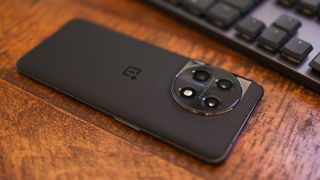
If we could use one word to describe the OnePlus 11 5G, it would be "balanced". The phone balances a very fair price with a rich feature set and a powerful camera system, and importantly – doesn't pull up any real red flags.
By going back to its roots, OnePlus has created a phone that doesn't need to compete on every single feature. It costs less than the incredibly expensive iPhone 14 Pro and Samsung Galaxy S23 Ultra, so its zoom range can afford to be pared back, and the lack of wireless charging isn't a deal-breaker.
In the core areas, you need your smartphone to be great – design, screen, primary camera, performance, and battery life – OnePlus absolutely nails it. While in the past, therefore, we weren't sold on OnePlus being absorbed into Oppo, if this phone's anything to go by, the future is once again bright for this once plucky upstart.
Read more: OnePlus 11 Pro 5G review
The best flagship at lower price

The Google Pixel 8 is a very safe bet for photographers who want a balanced phone. Yes, you have to sacrifice a little manual control – no pro mode or access to 50MP RAW photos isn't ideal. But for a point-and-shoot mobile, nothing in the Pixel's price range can best it.
Google's photo processing is tasteful and still ekes out loads of shadow detail, the large sensor does great things with close-up photos, blurring out the background naturally, and lowlight scenes, brightening things up reliably. The phone won't be for photography purists, but it will likely check everyone else's boxes from a camera point of view.
As for the rest of the phone – sure, more consistent battery performance would have been ideal in our week with the phone. The inclusion of wireless charging and IP68 water resistance is both a boon at the price, though, and after our third day with the phone, it always kept us alive from morning to night.
The best last-gen iPhone
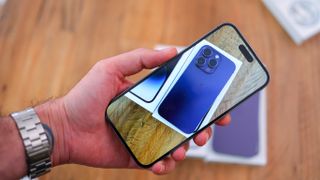
The iPhone 14 Pro Max is now a generation old, but you'd barely know it. Compared to the iPhone 14 Pro, it shares the same cameras and tech but boasts a bigger screen (6.7 inches versus 6.1 inches).
The Pro Max also has a slightly longer battery life of up to 28 hours of video playback versus up to 22 hours on the smaller 14 Pro. It might be tempting to pick the Pro Max over the regular Pro model just to get ‘the best of everything’.
The regular Pro costs enough, so why not take that last step and get the bigger screen? Well, some may simply find it too big to be comfortable to use every day. There's no doubt the iPhone 14 Pro Max is still a truly stunning camera phone, whether you shoot stills or video, and now it's a last-gen handset, you can find some tempting deals.
Read more: iPhone 14 Pro Max review
How we test camera phones
As a photography website, we pay special attention to the photo and video quality of camera phones. We rate resolution, noise, and color rendition in the context of what rival phone cameras can do, and where there are any special features, such as ‘night modes’ or ‘portrait modes’, we check that these perform as the makers describe. We also take a look at what features the phone might include for viewing and editing photos and video.
Camera phones are all-around digital assistants too, of course, so we also check out how smart the operating system is at handling general day-to-day usage. Finally, we look at phone usability, and practicality – such as design, screen, ports, and battery life.
How to choose the best camera phone
First things first, you need to pick if you would like an Android or an Apple phone.
This will depend on how much you currently rely on Apple services like iMessage, iCloud or even Apple's Notes app. If you can't give them up, then you are best sticking with the iPhone, and which one you get depends on if you want a big or a medium-sized phone, how advanced you need the cameras to be and how much you are willing to spend. We rate all of Apple's cameras very highly, going from the iPhone 15 Pro Max at the top end to the more affordable iPhone 15 model.
If you don't use Apple services (or can live without them), then you might want to take a look at an Android phone. Your choices are very broad here, and include new devices like folding phones. The two best Android phones at the moment are the Google Pixel 8 Pro and Samsung Galaxy S23 Ultra. Google includes more of its own services as standard like Google Photos and the amazing Google Pixel camera. Samsung also has its own set of Samsung apps that fulfil the same purposes in their own style. So pick the phone and apps whos design appeals most to you.
FAQs
What's the best camera phone?
If you're looking for the best camera phone that offers the best price and performance on the market there is no arguing with the Google Pixel 8 Pro, but we understand not everyone is a fan of Android, so if love Apple devices, I'd recommend the Apple iPhone 15 Pro Max.
Which is better, Apple iOS or Android?
Well, this is a question that has and will be debated seemingly forever. The truth is, they are both fantastic operating systems, that provide nearly all of the exact same functionality, just in slightly different ways, and both have all the major apps you are likely to use. There is no better OS, the one to pick is just the one that you enjoy using more on a day-to-day basis.




